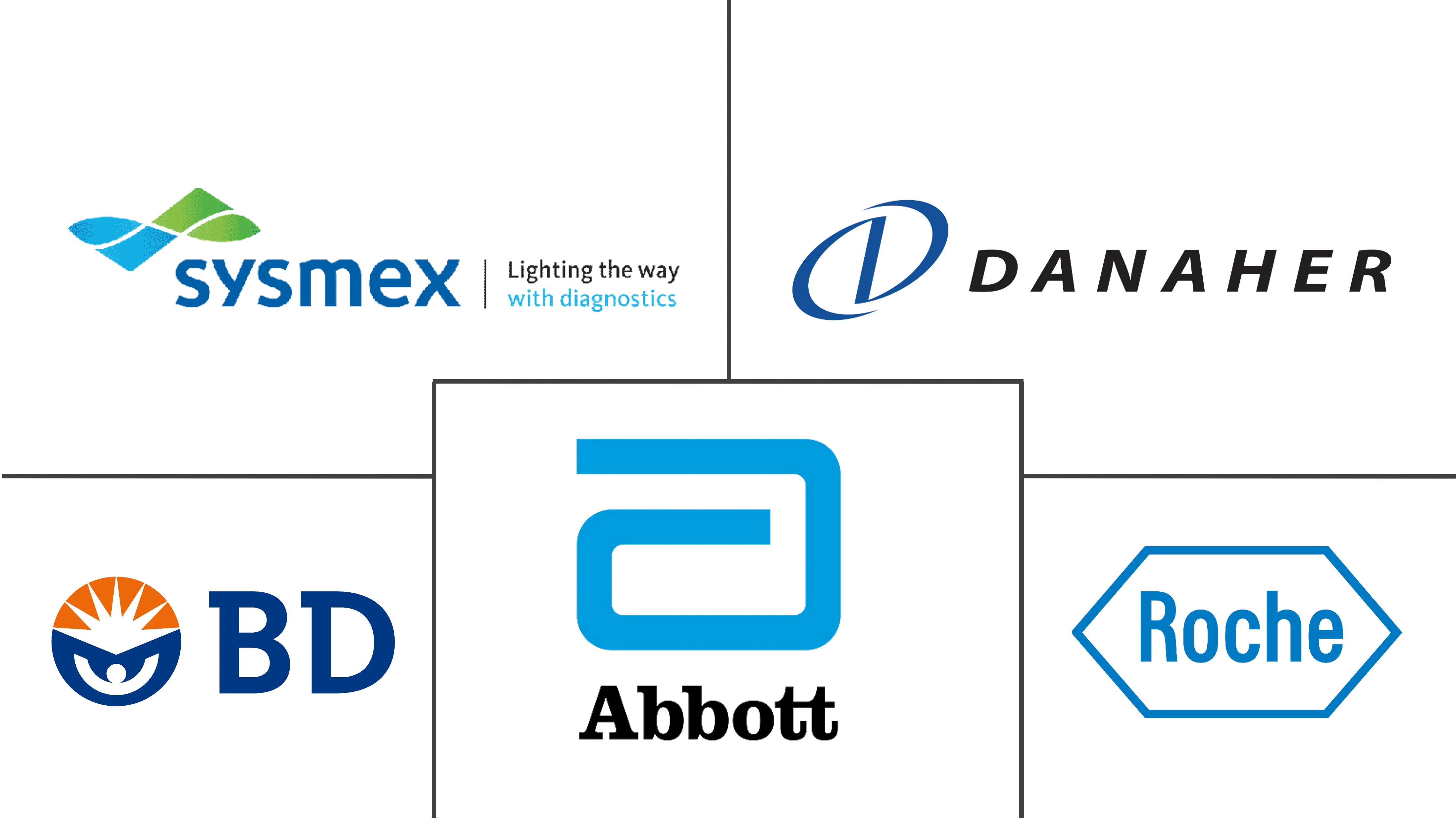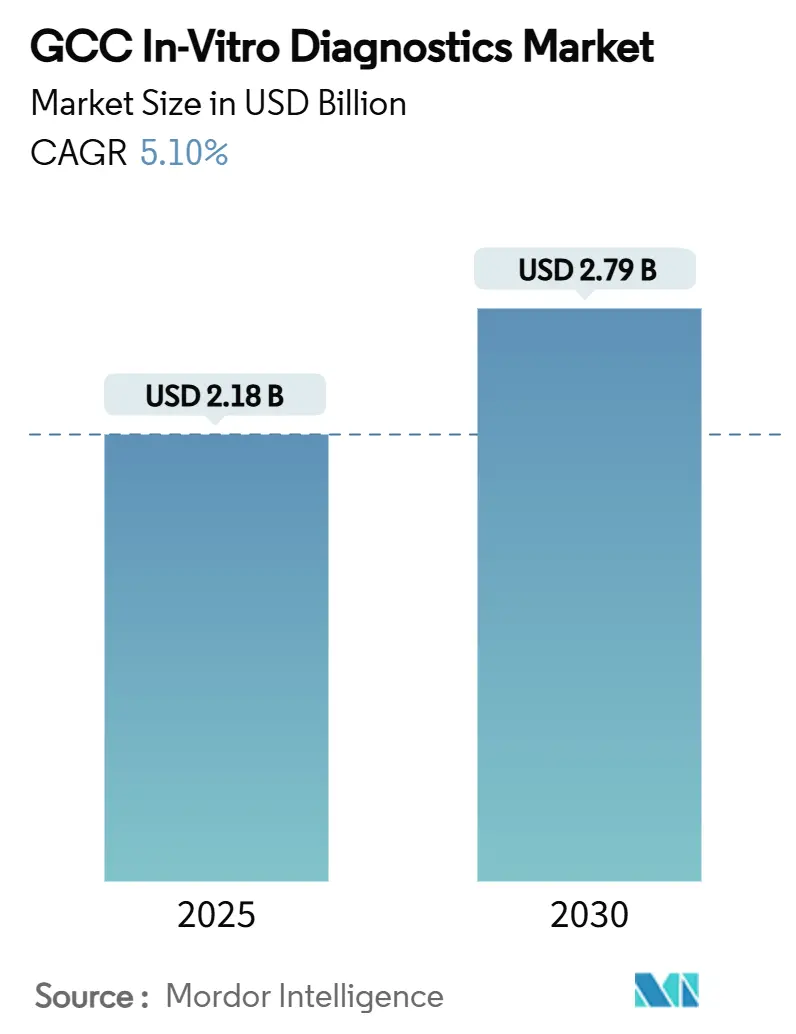
GCC In-Vitro Diagnostics Market Analysis by Mordor Intelligence
The GCC in-vitro diagnostics market size stands at USD 2.18 billion in 2025 and is forecast to reach USD 2.79 billion by 2030, translating into a 5.1% CAGR for the period. The expansion is being propelled by Vision 2030 reforms in Saudi Arabia, parallel modernization programs in the UAE and Qatar, and a deliberate shift from treatment-centric care models to prevention-oriented systems where laboratory evidence guides early clinical decisions. The GCC in-vitro diagnostics market is responding to post-pandemic vigilance, rapidly rising diabetes prevalence, and sustained government spending that favors advanced testing infrastructure. Large reference laboratories are investing in high-throughput immunochemistry and molecular platforms, while hospitals are upgrading bedside testing to improve turnaround times. The GCC in-vitro diagnostics market also benefits from a swelling health-insured expatriate base, streamlined CPT-based reimbursement, and growing importer–manufacturer partnerships that localize reagent filling and software support. Competitive intensity is sharpening as regional chains integrate artificial intelligence into workflows and multinationals hedge against supply risk by co-developing local manufacturing.
Key Report Takeaways
- By technique, immunochemistry led with a 26.3% revenue share of the GCC in-vitro diagnostics market in 2024 while molecular diagnostics is projected to expand at an 11.4% CAGR through 2030.
- By product category, reagents and consumables captured 61% of the GCC in-vitro diagnostics market share in 2024; software and services show the fastest outlook at a 13.7% CAGR to 2030.
- By usability, disposable IVD devices retained 88.5% share in 2024; home-use disposable devices are expanding at a 11.5% CAGR to 2030.
- By application, infectious disease testing commanded 34.2% of the GCC in-vitro diagnostics market size in 2024 and oncology diagnostics is advancing at a 12.1% CAGR over 2025-2030.
- By end user, diagnostic laboratories held 55.6% of the GCC in-vitro diagnostics market in 2024 while the home-care and self-testing setting posts the highest forecast CAGR at 12.3%.
- By diagnostic approach, centralized laboratory testing retained 68.9% of the GCC in-vitro diagnostics market in 2024; point-of-care platforms are expected to grow 12.9% per year up to 2030.
GCC In-Vitro Diagnostics Market Trends and Insights
Drivers Impact Analysis
| Driver | (~) % Impact on CAGR Forecast | Geographic Relevance | Impact Timeline |
|---|---|---|---|
| Growing Burden of Chronic & Infectious Diseases Across GCC | +1.1% | All GCC countries, with highest impact in Saudi Arabia and UAE | Long term (≥ 4 years) |
| Government-Led Healthcare Capacity Expansion & Modernization | +1.4% | Saudi Arabia, UAE, Qatar | Medium term (2-4 years) |
| Rising Adoption of Advanced Diagnostic Technologies (Molecular, Digital, AI) | +0.9% | UAE, Saudi Arabia, Qatar | Medium term (2-4 years) |
| Favorable National Screening & Preventive Health Programs | +0.6% | Saudi Arabia, UAE, Kuwait | Medium term (2-4 years) |
| Expanding Health-Insurance Coverage Including Mandatory Expat Benefits | +0.4% | UAE, Saudi Arabia, Oman | Short term (≤ 2 years) |
| Source: Mordor Intelligence | |||
Growing Burden of Chronic & Infectious Diseases Across GCC
Diabetes affects between 8% and 22% of GCC citizens, creating an economic drain estimated at USD 50 billion in care costs and lost productivity. A 2024 study reported 152,854 deaths and 3 million potential life-years lost to nine non-communicable diseases, translating into USD 23.9 billion in losses. This burden stimulates continuous glucose monitoring demand and keeps infectious disease surveillance budgets intact because expatriate mobility and religious tourism sustain cross-border pathogen risks. Saudi Arabia increased its public health outlay in response, and PCR networks built for COVID-19 testing are now redeployed for tuberculosis and respiratory virus panels. The GCC in-vitro diagnostics market therefore gains steady volume from both chronic disease follow-up and outbreak preparedness.
Government-Led Healthcare Capacity Expansion & Modernization
Saudi Arabia targets a jump in private hospital capacity from 23% to 68% under Vision 2030, while the UAE positions specialized oncology and transplant centers to attract medical tourists. Qatar allocates capital to digital hospital ecosystems that embed laboratory automation. The construction wave demands integrated laboratory networks that run 24/7 with minimal error, benefiting vendors who can supply middleware, track-and-trace logistics, and workforce training. These investments reshape procurement criteria: authorities look beyond device cost toward uptime, reagent security, and data interoperability, factors that redefine supplier rankings within the GCC in-vitro diagnostics market.
Rising Adoption of Advanced Diagnostic Technologies
AI platforms now assist pathologists in slide screening and automate molecular assay interpretation. Saudi Arabia’s National Platform for Healthcare Information Exchange creates a standardized data backbone that connects laboratory results with primary-care portals[1]Riyadh Valley Company, “MedTech Report,” rvc.com.sa. PCR instruments purchased in 2021 are repurposed for oncology and pharmacogenomics, while next-generation sequencing supports national genome projects in Qatar. Vendors differentiate through cloud analytics and real-time quality control dashboards, which improve throughput and reduce error rates. As a result, the GCC in-vitro diagnostics market experiences revenue migration from hardware replacement cycles toward subscription-based analytics modules.
Favorable National Screening & Preventive Health Programs
Vision 2030 mandates periodic diabetes, cardiovascular, and cancer checks for insured Saudis, and the UAE is adding vitamin D and colonoscopy reimbursement triggers. Structured screening produces predictable specimen volumes that let laboratories plan reagent inventory and depreciation schedules with greater accuracy. Preventive focus broadens panels beyond infection markers to include genetic risk profiles and metabolic biomarkers, stimulating demand for multiplex assays. These nationwide programs therefore convert episodic demand into annuity-style revenue, strengthening the growth profile of the GCC in-vitro diagnostics market.
Restraints Impact Analysis
| Restraint | (~) % Impact on CAGR Forecast | Geographic Relevance | Impact Timeline |
|---|---|---|---|
| Heavy Reliance on Imports and Resultant Cost Pressures | -1.0% | All GCC countries | Medium term (2-4 years) |
| Complex & Heterogeneous Regulatory Approval Processes | -0.6% | All GCC countries, with highest impact in Saudi Arabia | Medium term (2-4 years) |
| Workforce Constraints in Specialized Laboratory Skills | -0.4% | All GCC countries, with highest impact in smaller markets (Oman, Bahrain) | Short term (≤ 2 years) |
| Source: Mordor Intelligence | |||
Heavy Reliance on Imports and Resultant Cost Pressures
More than 80% of reagents, plastics, and capital equipment are sourced offshore, exposing laboratories to freight bottlenecks and currency swings. While the UAE and Saudi Arabia announce biotech parks and reagent fill-finish plants, commercial output will take time to reach scale. Interim countermeasures include framework contracts that hedge exchange risk and consignment stock warehousing. Smaller providers in Oman and Bahrain struggle to secure volume discounts, which may limit decentralized testing penetration and slow overall uptake in the GCC in-vitro diagnostics market.
Complex & Heterogeneous Regulatory Approval Processes
The SFDA’s in-house IVD guidance and its new AI device dossier rules require granular performance data and local representative responsibilities[2]Gulf Central Committee for Drug Registration, “Guidance on the Development of IVDs for In-House Use,” gccbdi.org. Parallel submissions to Dubai or Doha regulators add cost and delay. Harmonization talks progress, yet device makers still tailor labeling, vigilance reporting, and language requirements for each jurisdiction. This fragmentation raises the barrier to entry for niche assay developers and can postpone the launch of breakthrough technologies, tempering growth momentum within the GCC in-vitro diagnostics market.
Segment Analysis
By Technique: Molecular Diagnostics Reshaping Testing Paradigms
Immunochemistry commanded 26.3% of the GCC in-vitro diagnostics market in 2024, fueled by high-volume HbA1c, thyroid, and cardiac marker panels. Molecular assays accounted for a smaller share but register the fastest 11.4% CAGR because PCR capacity built during the pandemic now tackles oncology biomarkers and pharmacogenomic profiling. The GCC in-vitro diagnostics market size for molecular assays is projected to expand as next-generation sequencing instruments enter reference laboratories. Hematology and microbiology remain clinical staples, whereas histochemistry grows alongside expanding cancer programs. The region’s diabetes epidemic sustains self-blood glucose testing, and coagulation analyzers find steady demand from cardiovascular disease management. Continued AI integration in result interpretation keeps immunochemistry competitive, yet the molecular upgrade cycle drives incremental reagent revenue for suppliers.
Digitalization shapes future workflows. Saudi and Emirati labs integrate middleware that auto-verifies immunoassay runs, while cloud-based databases archive molecular raw data for secondary analysis. Vendors able to deliver both assay kits and analytics secure multi-year managed service contracts. This convergence of wet chemistry and informatics underpins future differentiation in the GCC in-vitro diagnostics market.
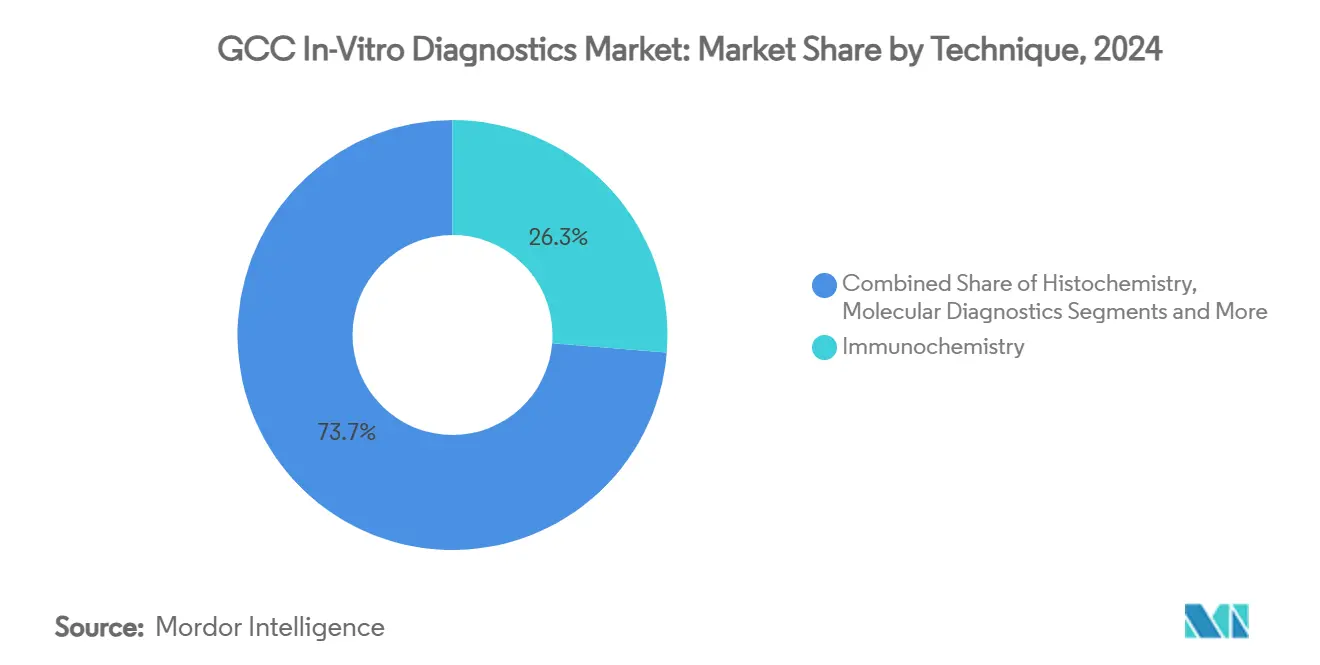
Note: Segment shares of all individual segments available upon report purchase
By Product: Software Integration Driving Value Creation
Reagents and consumables generated 61% of GCC in-vitro diagnostics market revenue in 2024, reflecting repeat-purchase dependency. Capital equipment sales benefit from periodic automation upgrades, yet software and services, now a single-digit share, will post a 13.7% CAGR to 2030. AI modules that flag result anomalies, auto-triage critical values, and streamline quality control transform laboratories into data hubs. The GCC in-vitro diagnostics market share for software climbs as providers shift from one-time analyzer sales to recurring license models. Regional partnerships, such as Roche Diagnostics and Burjeel Holdings, illustrate the pivot toward digital diagnostics.
Instrument suppliers bundle reagent leases with uptime guarantees while co-hosting dashboards in sovereign clouds to meet data-residency laws. Local value-added distributors hire bioinformaticians, turning service revenue into a strategic lever. This blended portfolio of chemistry, equipment, and code redefines competitive positioning in the GCC in-vitro diagnostics market.
By Usability: Disposables Dominate While Home Testing Accelerates
Disposable devices held 88.5% market share in 2024 because single-use formats match infection-control norms and insurer payment codes. Reusable cartridges cater to specialized coagulation and some point-of-care chemistry analyzers but remain niche. Within disposables, home-use kits for glucose, cholesterol, and pregnancy display 11.5% CAGR, reflecting rising chronic disease self-management. Wi-Fi or Bluetooth-enabled meters transmit readings to care portals, fitting GCC telehealth policies that aim to shift 50% of routine care to virtual channels by 2028. The GCC in-vitro diagnostics market integrates wearable sensors and smartphone apps that gamify adherence, expanding manufacturer revenue beyond strip sales toward subscription analytics.
By Application: Cancer Diagnostics Gaining Momentum
Infectious diseases retained 34.2% of GCC in-vitro diagnostics market revenue in 2024, buttressed by mandatory screening for inbound pilgrims and expatriates. Diabetes testing remains sizable due to prevalence but oncology assays exhibit a 12.1% CAGR outlook. Governments add breast, colon, and bladder cancer panels to coverage lists; Guardant Health’s liquid biopsy adoption in Abu Dhabi and Wellesta’s VECanDx test introduction illustrate the trend. Cardiology panels hold steady importance, and autoimmune diagnostics benefit from improved awareness. Emerging genetic wellness screens enter employer health programs, expanding the breadth of the GCC in-vitro diagnostics market.
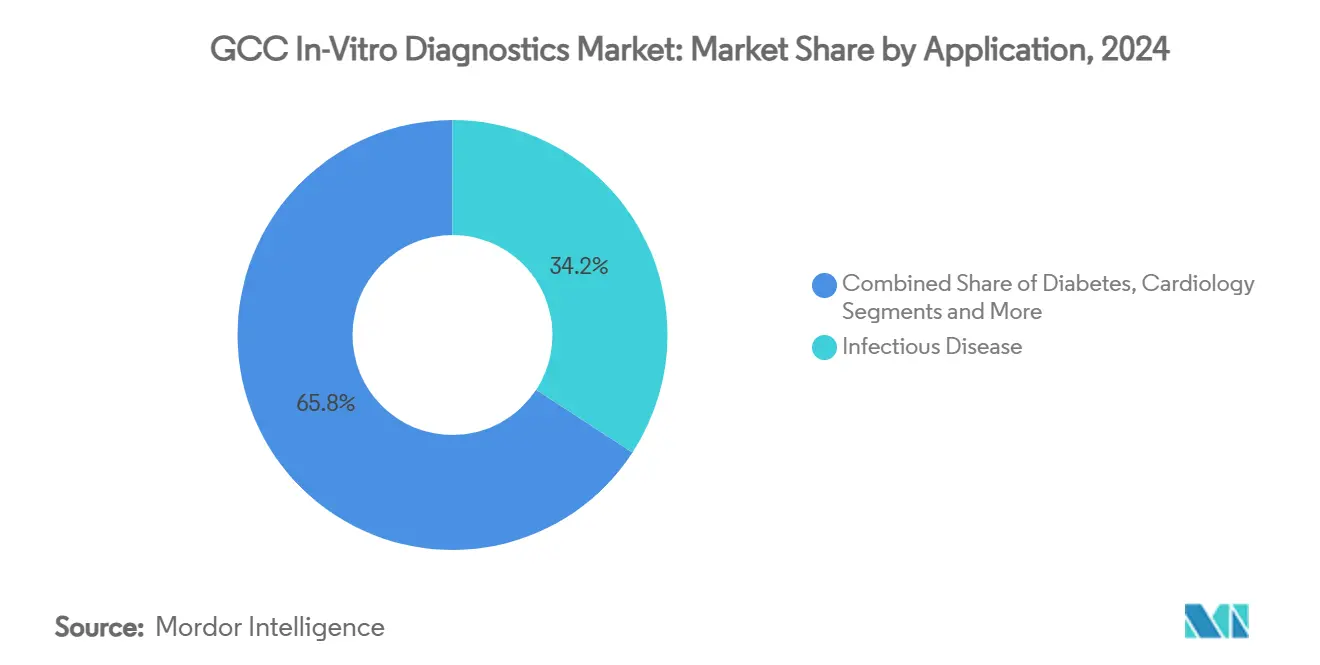
Note: Segment shares of all individual segments available upon report purchase
By End User: Self-Testing Environments Expanding Rapidly
Diagnostic laboratories captured 55.6% of spending in 2024 through consolidated reference operations. Hospitals rely on these labs for high-complexity tests but keep STAT analyzers for emergencies. Home-care and self-testing sites show 12.3% CAGR as insurers reimburse connected glucometers and coagulation self-tests. SGS training on the EU IVDR transition, promoted in the region, accelerates manufacturer readiness for direct-to-consumer kits. Retail clinics inside malls and workplaces join the “other” category, widening specimen access points within the GCC in-vitro diagnostics market.
By Diagnostic Approach: Point-of-Care Gaining Strategic Importance
Central laboratories contributed 68.9% of revenue in 2024; however, point-of-care solutions add 12.9% annual growth as clinicians demand immediate actionable results. Rapid antigen respiratory panels, sexually transmitted infection tests, and bedside troponin kits shorten emergency department cycles. Vendors such as Fapon showcase one-stop platforms using CLIA, LFA, and FIA technologies, coupled with local manufacturing commitments that dovetail with import-substitution policies. This decentralized testing momentum reshapes procurement criteria and rewards suppliers who integrate connectivity, quality controls, and flexible cartridge menus.
Geography Analysis
Saudi Arabia represents the largest contributor to GCC in-vitro diagnostics market revenue, buoyed by a high population base and the Kingdom’s aggressive health-capital expenditure. The market benefits from Vision 2030’s pledge to triple private sector involvement, which funnels investment into molecular laboratories and AI-enabled quality programs. Saudi providers negotiate reagent-rental contracts that stabilize cash flows and rely on domestic biomanufacturing plans to hedge import costs. The GCC in-vitro diagnostics market size for Saudi Arabia is set to widen as oncology and genetics programs mature.
The UAE leads on per-capita spending and technology adoption. Large hospital groups integrate robotics in sample handling and treat diagnostics as a tourism magnet, drawing international patients seeking rapid precision reports. Mandatory insurance for expatriates expands test volume, and Dubai Science Park’s reagent fill-finish projects begin to localize supply. These dynamics keep the GCC in-vitro diagnostics market vibrant in the Emirates.
Qatar, Kuwait, Oman, and Bahrain collectively add incremental growth through specialty centers and national screening drives. Qatar’s genome initiative accelerates sequencing demand, while Kuwait’s preventive health programs stimulate immunoassay volumes. Smaller markets focus on decentralizing services to reach remote areas, turning to cloud-linked point-of-care devices. Import dependence remains a shared vulnerability, yet harmonized procurement among these states improves negotiating leverage, reinforcing a unified GCC in-vitro diagnostics market direction.
Competitive Landscape
The GCC in-vitro diagnostics market exhibits moderate concentration. Multinationals such as Roche, Abbott, Siemens Healthineers, and Beckman Coulter dominate high-throughput analyzers and reagent leases. Regional groups like Al-Borg Diagnostics and PureHealth strengthen scale through chain acquisitions and strategic digital upgrades. Partnerships that merge hardware with analytics differentiate market leaders: Roche aligns with Burjeel to embed middleware dashboards; Fapon signs a memorandum with Dubai Chambers to accelerate local manufacturing.
White-space growth lies in localized reagents and assays designed for GCC genomic traits. Disruptive entrants leverage next-generation sequencing and AI-augmented digital pathology to carve niches. Investors, including Quadria’s USD 1 billion fund, assign 25% to GCC diagnostics, signaling capital depth for innovators[3]AGBI, “Quadria commits 25% from USD 1 bn healthcare fund to GCC,” agbi.com. Success factors now extend beyond sensitivity ratings to include supply resilience, data integration, and regulatory fluency, shaping future share allocation within the GCC in-vitro diagnostics market.
GCC In-Vitro Diagnostics Industry Leaders
-
Abbott Laboratories.
-
Danaher Corporation
-
F. Hoffmann-La Roche AG
-
Becton, Dickinson and Company
-
Sysmex Corporation
- *Disclaimer: Major Players sorted in no particular order
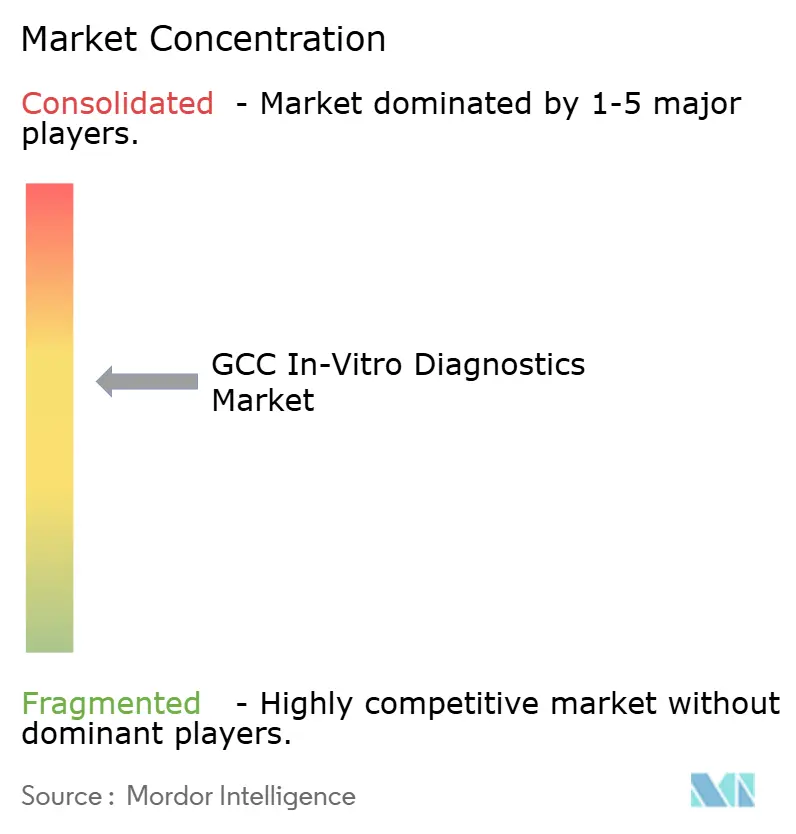
Recent Industry Developments
- May 2025: Roche Diagnostics intensified engagement in Saudi Arabia to deliver preventive, personalized, data-driven healthcare aligned with Vision 2030.
- May 2025: Quadria committed 25% of its USD 1 billion healthcare fund to GCC expansion, channeling fresh capital into laboratory consolidation and AI workflows.
GCC In-Vitro Diagnostics Market Report Scope
As per the scope of the report, In-vitro diagnostics is defined as a medical device used alone or in combination, intended by the manufacturer for the in vitro examination of specimens derived from the human body solely or principally to provide information for diagnostic, monitoring, or compatibility purposes.
The Gulf Cooperation Council In-vitro Diagnostics Market is segmented by Technique (Histochemistry, Molecular Diagnostics, Hematology, Self-blood Glucose Testing, Immunochemistry, and Other Techniques), Product (Instrument, Reagent, and Other Products), Usability (Disposable IVD Device and Reusable IVD Device), Application (Infectious Disease, Diabetes, Cancer/Oncology, Cardiology, Autoimmune Disease, and Other Applications), End User (Diagnostic Laboratories, Hospitals and Clinics, and Other End Users), Diagnostic Approach (Point-of-Care Diagnostics, Centralized Laboratory-based, and Diagnostics). The report offers the value (in USD million) for the above segments.
| Histochemistry |
| Molecular Diagnostics |
| Hematology |
| Self-Blood Glucose Testing |
| Immunochemistry |
| Microbiology |
| Coagulation |
| Other Techniques |
| Instruments |
| Reagents & Consumables |
| Software & Services |
| Disposable IVD Devices |
| Reusable IVD Devices |
| Infectious Disease |
| Diabetes |
| Cancer / Oncology |
| Cardiology |
| Autoimmune Disease |
| Other Applications |
| Diagnostic Laboratories |
| Hospitals & Clinics |
| Home-Care & Self-Testing Settings |
| Other End Users |
| Point-of-Care Diagnostics |
| Centralised Laboratory-based Diagnostics |
| By Technique | Histochemistry |
| Molecular Diagnostics | |
| Hematology | |
| Self-Blood Glucose Testing | |
| Immunochemistry | |
| Microbiology | |
| Coagulation | |
| Other Techniques | |
| By Product | Instruments |
| Reagents & Consumables | |
| Software & Services | |
| By Usability | Disposable IVD Devices |
| Reusable IVD Devices | |
| By Application | Infectious Disease |
| Diabetes | |
| Cancer / Oncology | |
| Cardiology | |
| Autoimmune Disease | |
| Other Applications | |
| By End User | Diagnostic Laboratories |
| Hospitals & Clinics | |
| Home-Care & Self-Testing Settings | |
| Other End Users | |
| By Diagnostic Approach | Point-of-Care Diagnostics |
| Centralised Laboratory-based Diagnostics |
Key Questions Answered in the Report
What is the current value of the GCC in-vitro diagnostics market?
The market stands at USD 2.18 billion in 2025 and is projected to rise to USD 2.79 billion by 2030.
Which technique leads GCC diagnostic spending?
Immunochemistry holds 26.3% of 2024 revenue, driven by routine chronic disease panels.
How fast is molecular diagnostics growing in the GCC?
Molecular assays are forecast to advance at an 11.4% CAGR through 2030 as PCR and sequencing move beyond infectious diseases.
Why are reagents and consumables so dominant?
Imported reagents generate recurring sales and captured 61% of 2024 market revenue because most testing volume depends on disposable cartridges and kits.
What role does point-of-care testing play in GCC healthcare?
Point-of-care platforms are expanding 12.9% per year, empowering clinicians with rapid results and supporting national goals for decentralized and preventive care.
Page last updated on:
